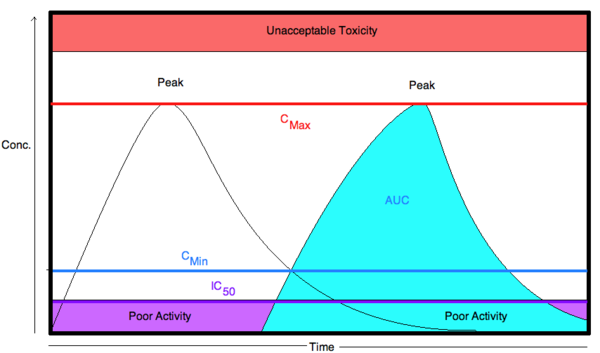Pharmacokinetics
From Proteopedia
Pharmacokinetics (PK) measures the variations of drug levels in the body with relation to how much compound you take and time since taking the pharmaceutical compound.
Contents |
Bioavailability (F)
This is the amount of a drug that actually makes it into your bloodstream as compared to the amount you put in your mouth, inhale, or inject. Since the body has dozens of defense mechanisms to keep foreign compounds out of your blood, simply getting the active compound into your bloodstream is pretty difficult. Drug compounds must pass through the hostile stomach, must avoid setting off an immune response, must avoid being metabolized by the liver and ultimately be absorbed by the small intestine in order to make it into the blood.
Protein Binding
Once a drug compound has successfully entered the blood stream, an important consideration is how much of the drug is freely available to enter cells versus how much is bound by plasma proteins. Proteins bind drug compounds at varying rates, decreasing the rate at which drug compounds are absorbed by cells. Without such proteins, many compounds, like adrenaline, would be absorbed too fast and would not reach all of the targets in the body. Many drugs are so completely bound by protein that their availability toward absorption by cells is nearly zero.
Barriers
Certain parts of the body have barriers to entry. Cell membranes for example have a highly hydrophobic interior which excludes polar molecules to enter. Thus most drugs must pass into cells through membrane channels and membrane transport proteins. Another important barrier is the so-called “blood brain barrier”, which protects your brain and spinal cord from toxins. This is a good thing as the brain is a sensitive place, but it can be detrimental to pharmaceutical scientists attempting to develop a compound to function in the brain.
Dose (D)
Quite simply it is the mass of active compound you take, typically measured in mg.
Concentration (C0) or (Css)
It's either the initial or steady state concentration of the drug in the blood plasma.
Cmax
This is the peak concentration of a drug after administration. It is related to the short-term side effects of the drug which typically include nausea, or lethargy.
Cmin
This is the lowest concentration a drug reaches before a second administration of the drug occurs. Most manufacturers try to maintain a Cmin about 3 times the IC50 to allow for a "buffer" room above the critical effectiveness cutoff.
Half Life (T1/2)
Typically measured in hours, it is the time required for the concentration of the drug in your blood to be reduced by ½. Once a drug enters the blood, the body will immediately start to remove it. T1/2 gives an indication of how long the drug will be active for.
Tmax
How long after taking the drug does the drug hit its Cmax, typically measured in hours. It is a measure of how long you have to wait before the drug hits maximum effectiveness along with when you can expect short term side effects to reach their peak.
Volume of Distribution (Vd)
The volume in which a drug is distributed after it has been injected intravenously and has equilibrated between the blood plasma and surrounding tissues. Although this value has no literal physiological meaning, Vd is indicative of the extent of distribution of the drug. In general, highly plasma protein bound drugs will have a small Vd while those drugs that are bound within tissues will have a large Vd. As a rough approximation:
| Vd Distribution Extent Comparisons | |
|---|---|
| Vd (L) | Extent of Distribution |
| 5 | Only In Plasma |
| 5-20 | In Extracellular Fluids |
| 20-40 | In Total Body Fluids |
| >40 | In Deep tissues; Bound to Peripheral Tissues |
Clearance (Cl)
This is a measure of the volume of plasma cleared of the drug per unit of time. In other words, how much of your blood is rid of the drug per unit of time.
Area Under the Curve (AUC)
This is a measurement of the total exposure someone has to the drug. It is represented by the area under the PK curve. It is the integral of the concentration over time. It is related to the long-term side effects of a drug, i.e. greater exposure to any foreign compound, the more likely long-term side effects are.
Inhibitory Concentration (IC50)
This is a measurement of the half maximal inhibitory concentration. In other words, it is a measure of how much drug must be taken before 50% of the particular biochemical function is inhibited. It is the typical measurement of drug potency in which lower values indicate increased potency.

